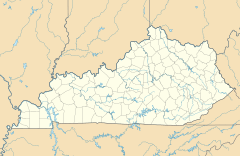Sycamore, Kentucky facts for kids
Quick facts for kids
Sycamore, Kentucky
|
|
|---|---|

Location of Sycamore in Jefferson County, Kentucky
|
|
| Country | United States |
| State | Kentucky |
| County | Jefferson |
| Area | |
| • Total | 0.02 sq mi (0.04 km2) |
| • Land | 0.02 sq mi (0.04 km2) |
| • Water | 0.00 sq mi (0.00 km2) |
| Elevation | 696 ft (212 m) |
| Population
(2020)
|
|
| • Total | 166 |
| • Density | 9,764.71/sq mi (3,872.89/km2) |
| Time zone | UTC-5 (Eastern (EST)) |
| • Summer (DST) | UTC-4 (EDT) |
| ZIP Code |
40223
|
| FIPS code | 21-75190 |
| GNIS feature ID | 2405556 |
Sycamore is a small city located in Jefferson County, Kentucky, in the United States. It is known as a "home rule-class city," which means it has the power to manage its own local government. According to the 2010 census, about 160 people lived in Sycamore.
Contents
Where is Sycamore Located?
Sycamore is found in the eastern part of Jefferson County. It shares its borders with a few other communities. To the east, you'll find Douglass Hills. To the south and west, it borders Blue Ridge Manor. The rest of Sycamore is surrounded by the larger Louisville/Jefferson County area.
A major road, U.S. Route 60 (also known as Shelbyville Road), runs along the southern edge of the city. If you travel about 11 miles (18 kilometers) to the west, you will reach Downtown Louisville.
How Big is Sycamore?
Sycamore is a very small city in terms of its area. Based on information from the United States Census Bureau, the total area of Sycamore is only about 0.04 square kilometers (which is about 0.02 square miles). All of this area is land; there are no large bodies of water within the city limits.
Who Lives in Sycamore?
| Historical population | |||
|---|---|---|---|
| Census | Pop. | %± | |
| 1980 | 195 | — | |
| 1990 | 70 | −64.1% | |
| 2000 | 159 | 127.1% | |
| 2010 | 160 | 0.6% | |
| 2020 | 166 | 3.8% | |
| U.S. Decennial Census | |||
Let's look at how the population of Sycamore has changed over the years and what the people who live there are like.
Population Changes Over Time
The number of people living in Sycamore has varied. In 1980, there were 195 residents. By 1990, the population had decreased to 70 people. However, it grew again to 159 residents in 2000 and stayed almost the same at 160 in 2010. The most recent count in 2020 showed 166 people living in Sycamore.
A Look at the Community in 2000
According to the census from the year 2000, there were 159 people living in Sycamore. These people lived in 89 different homes, and 45 of these were families. The city was quite densely populated, with about 5,837 people per square mile (or 2,253 people per square kilometer). There were 90 housing units in total.
Most of the residents in 2000 were White (83.02%). There were also African American residents (15.09%) and Asian residents (1.89%). A small percentage (2.52%) of the population identified as Hispanic or Latino.
Households and Families
Out of the 89 households in 2000, about 15.7% had children under 18 living with them. About 31.5% were married couples living together. Some households (16.9%) had a female head of the house with no husband present. Nearly half (49.4%) were not traditional families. Many households (46.1%) consisted of just one person, and 18.0% of these were people aged 65 or older living alone. On average, there were 1.79 people per household and 2.42 people per family.
Age Distribution
The population in Sycamore in 2000 was spread out across different age groups. About 15.7% of the residents were under 18 years old. A small group, 6.3%, were between 18 and 24. People aged 25 to 44 made up 18.9% of the population. The largest group, 33.3%, was between 45 and 64 years old. Finally, 25.8% of the residents were 65 years or older. The average age in the city was 51 years old.
Income and Economy
In 2000, the average income for a household in Sycamore was $48,750 per year. For families, the average income was $60,313. Men earned an average of $36,875, while women earned $33,750. The per capita income (which is the average income per person) for the city was $26,239. It's important to note that no families and only 4.7% of the total population were living below the poverty line at that time.
Images for kids
See also
 In Spanish: Sycamore (Kentucky) para niños
In Spanish: Sycamore (Kentucky) para niños





